Video
Let's practice analyzing an animal video!
In this video, we see a chimpanzee carrying a young white tiger in a pool and handing it off to a lady, whom the chimpanzee then guides to the edge of the pool. The captions read: “He was worried about the tiger, he gave him to me, & guided us to [safety]”.
This video has a few key parts. Where is this being taken? What interaction are we watching? Why are these two animals together?
The first thing that you should do is check the comments and go to the source! The comments already warn about animal mishandling, but we want to see for ourselves if we can. Clicking on the source takes us to a TikTok account, which then links to a wildlife safari experience’s website. This shows lots of pictures and videos of different animals that would not normally interact in the wild, and especially not with humans, including a variety of large carnivores and other animals that can present a real danger to humans and each other. The organization states that its mission is conservation education, and a number of the animals are described as rescued, but moving to the ‘Tiger Tales’ section of their site shows an interesting rebuttal to the filming done there by the ‘Tiger King’ crew, as well as other articles revealing disapproval from the Humane Society of the United States. They also knock the American Zoological Association (AZA) for furthering a disagreeable ‘ideology’, but the AZA is one of the most trustworthy animal welfare organizations that you can find, as it informs animal care in accredited zoos around the US. You can read there that the institution breeds tigers without the intention of releasing them into the wild, but claims to be a genetic backup for wild tigers and raising awareness for conservation. A quick search of white tigers - which we see in the video - shows that they are severely inbred. Reviewing their website further shows that they allow anyone to sign up and get their hands on baby animals of endangered species, which is not safe for guests or for the animals. There are a lot of reasons to distrust this organization.
Back to the video - the biggest thing about the setting (besides that it’s not a natural setting for either animal) is that this is a swimming pool, which is probably chlorinated. Searching about chlorine and animals shows that chlorine may be safe, unless the individual is particularly sensitive to it, and depending on how long the animal is in the pool (which we can’t tell here). Additionally, chimpanzees and tigers should not be interacting. We know that, according to good practices of animal welfare as illustrated in the infographic post, a responsible rehabilitation center or other facility should keep these animals separate and emulate life in the wild as best they can, with official (AZA) approved habitats. The animal should normally have limited contact with humans, particularly if it was born in captivity and not already socialized (mishandled) by an exotic pet owner. (Exotic pets that have been rescued may need continued social enrichment in order to stay happy - but should not have gotten like this in the first place).
Overall, because of what we found on the source website, we feel that this video should be avoided, and potentially reported if you feel like making a case against it on the grounds of animal abuse. The organization that sponsors this video is extremely questionable at best, shows evidence of animal abuse (a white tiger cub is enough to confirm that, let alone putting those two animals together - and in a chlorinated pool, no less).
This video was shared for educational purposes and to add a comment that others can find so that they can learn more - we are considering the educational benefit as outweighing the single-reblog engagement cost.
For a comic on how to analyze animal videos, check out pinned!
(via)
9K notes
·
View notes
Video
This one’s tricky!
In this video, we see a closeup of a lion. It sneezes a couple of times gently, opens its mouth, licks its lips, opens its mouth, and licks its lips again.
Here are some things to notice - can you tell who’s filming? Why are they filming the video? Where is the animal? Is anybody here in danger? Here’s what we gathered:
The filmer of the video isn’t obvious. The background moves slowly but smoothly, so this could very well be a human filmer, but there’s an unlikely possibility that it was taken by a drone or controllable camera. Another idea, then, is wondering why someone should be so close to a lion to film. Is it safe for the filmer? And is it ethical that the lion is so used to people, then? One commenter asks these questions but the answer isn’t on Tumblr or at the source, but going to Reddit, you can see people commenting things like “forbidden snuggles”. Overall, this video is very vague - this lion should be at a big cat sanctuary, which is nearly the only place where a big cat should be comfortable in this situation, and we don’t know if that’s the case or not. Aside from garnering comments from people that now want to snuggle a lion (and really shouldn’t), this video is pretty gray-area. After some critical thinking and checking the source and the comments, we can't tell how it was filmed and can't know for sure; we would share with a caption like "hope this was filmed at an animal sanctuary. cool lion".
Check out pinned for a comic on how to analyze animal videos!
Sneezing appears to bring up complex emotions for lions..
(Source)
9K notes
·
View notes
Video
In this video, we see someone and their dog snuggling in bed. The person pulls the covers down, and the dog grabs the covers, tucks the person in, and snuggles up again.
As usual - think about where the video is taken and why. What can you observe in the video - who is filming, who is in it, and what are they doing to the animal?
This is a fairly easy one to determine - the video is good for the animal. However, it’s still important to understand and be able to describe why. Dogs are a domesticated species, and you can tell that the dog is tame in the video because it wants to spend time with a human. This dog belongs in this setting. Aside from that, the most important thing is that the dog has free control over this situation and is choosing whether or not to participate. While a person initiated the activity shown in the video - pulling the covers down - the dog chooses what to do next. Also, while the video was probably filmed for viewers’ entertainment, the activity in the video is fairly neutral to the dog - it can almost be seen as a little game, which is enriching. This is a good example where a human can do something to an animal - even for views - but the filming of the video still shows good welfare for the dog.
If there was one question with the video, it’s that the caption calls the dog considerate, which is giving an animal a human attribute (anthropomorphism), which we tend to avoid in animal science and husbandry. We know that animals express emotions, but we don’t know exactly what the dog’s motivation is here. It’s nice to think that - but can we really say for sure?
Uwa. (2023, February 28). Do animals have feelings? examining empathy in Animals. UWA Online. Retrieved April 30, 2023, from https://online.uwa.edu/news/empathy-in-animals/
Check the pinned post for a comic on how to analyze animal videos!
Considerate doggy
(via)
15K notes
·
View notes
Text
In this video, we see a frog and a baby alligator sitting on a table in a house. Someone picks up a pot and pours water onto the frog, which backs up to exit the water stream. The alligator is next, and it closes its eyes and arches upwards in the water stream.
There are a few things that you should notice right away to analyze with this video. Take a moment and make a list of everything that you observe. You may start with what you see - you have two animals together, an alligator (aby) and a frog or thad. Also, the setting20a b0care of throughout its life by these caretakers. The fact that it is a baby is also concerning - how would a baby alligator end up in someone’s home? It was either bred as a pet or taken from the wild, both of which are not they are sitting on a table in someone’s home. Another important thing to note is that this is a 20opportunities for research. Scroll through comments, too - anybody can make any accusation or 0that they close a set of eyelids when submerged - that this gator’s ‘submerged’ behaviors have turned on and its head lifting is it trying to get air. However, even if you didn’t get to that conclusion - the way assurance the toad is treated, the two animals put together, and the baby alligator in a human household are all good reasons to distrust this video and consider reporting it.
Daley, J. (2019, October 7). How do we prevent pets from becoming exotic invaders? Scientific American. Retrieved April 30, 2023, from https://www.scientificamerican.com/article/how-do-we-prevent-pets-from-becoming-exotic-invaders/you can also then verify anything too. After checking into this - or thinking about it critically - check out our analysis below:
Now that you’ve observed, take a moment and consider the setting, situation, and the reason that this animal will be well taken care of throughout its life by these caretakers. The fact that it is a baby is also concerning - how would a baby alligator end up in someone’s home? It was either bred as a pet or taken from the wild, both of which are not ge see two behavioral responses from the animals in the video, which are both excellent opportunities for research. Scroll through comments, too - anybody can make any accusation or 0that they close a set of eyelids when submerged - that this gator’s ‘submerged’ behaviors have turned on and its head lifting is it trying to get air. However, even if you didn’t get to that conclusion - the way assurance the toad is treated, the two animals put together, and the baby alligator in a human household are all good reasons to distrust this video and consider reporting it.
Daley, J. (2019, October 7). How do we prevent pets from becoming exotic invaders? Scientific American. Retrieved April 30, 2023, from https://www.scientificamerican.com/article/how-do-we-prevent-pets-from-becoming-exotic-invaders/you can also then verify anything too. After checking into this - or thinking about it critically - check out our analysis below:
A good first step is to scroll through comments. Doing so reveals that this is likely an albino pixie frog, which are indeed kept widely as pets, though keeping a wild animal as a pet is considered unethical by some. The other, however - a baby alligator - should never be kept as a housepet (at best, it should remain in a realistic habitat in a rescue setting). If you consider the alligator’s entire lifespan, keeping a baby alligator is very different from keeping an adult alligator, and looking at how this has worked out in the past, you’d be right to be skeptical that this animal will be well taken care of throughout its life by these caretakers. The fact that it is a baby is also concerning - how would a baby alligator end up in someone’s home? It was either bred as a pet or taken from the wild, both of which are not good options. Then there’s the fact that it’s next to a frog, which it generally should not be interacting with in the wild; generally, alligators and frogs do not socialize with each other, and so this is probably a dangerous pairing. Then, there’s the animals’ responses to the water. The frog backs up and exits the water, showing that it did not want to have water poured on it. The person tries to follow the frog with the water and it steps out again, which shows that the person did not respect the frog’s choice to leave. The alligator is a little trickier - searching for a few different terms about gator stress behavior didn’t lead us anywhere, but a rather large number of comments on both reddit and tumblr stated that the gator behavior is not positive, and it’s plausible, knowing that gators spend time submerged - and finding online that they close a set of eyelids when submerged - that this gator’s ‘submerged’ behaviors have turned on and its head lifting is it trying to get air. However, even if you didn’t get to that conclusion - the way that the toad is treated, the two animals put together, and the baby alligator in a human household are all good reasons to distrust this video and consider reporting it.
Source on why pet gators are generally bad:
Daley, J. (2019, October 7). How do we prevent pets from becoming exotic invaders? Scientific American. Retrieved April 30, 2023, from https://www.scientificamerican.com/article/how-do-we-prevent-pets-from-becoming-exotic-invaders/
1 note
·
View note
Text
Let’s do some practice on how to analyze an animal video!
In the video, we see a cat by a curb. The cat looks off the road and seems to see something it’s interested in. It leaps towards it slowly, and plops down in the grass.
To start with, think about the cat, does it look healthy? Then the video itself, why is it being filmed and by who? Next, the behavior, is the cat exhibiting a healthy and natural behavior? Lastly, where is the cat, should it be there? Think about these questions - our analysis is below!
This cat looks pretty healthy. It’s being filmed doing a cat thing - it’s playing/hunting, and it’s just being filmed because it’s fun to see. That’s all great - but the cat is outdoors. Pet cats do not belong outdoors, as this poses serious welfare risks to themselves and the ecosystem around them (there are plenty of ways to provide a fulfilling and engaging environment for a cat indoors, and you should consider whether or not you can support this for a cat before adopting it). However, this cat is under supervision. If the cat is well trained and does not leave its yard (though this is questionable from the location of the video), then this may fall into more of a gray area - but we generally don’t suggest boosting videos of cats that are outdoors, especially when you can’t tell how the cat is supervised or limited. We're only sharing this for learning purposes, and so that others can look at our comments and learn too.
Tan, S. M. L., Stellato, A. C., & Niel, L. (2020, February 6). Uncontrolled outdoor access for cats: An assessment of risks and benefits. Animals : an open access journal from MDPI. Retrieved April 30, 2023, from https://www.ncbi.nlm.nih.gov/pmc/articles/PMC7070728/
Check pinned for an infographic on analyzing animal videos!
2K notes
·
View notes
Text

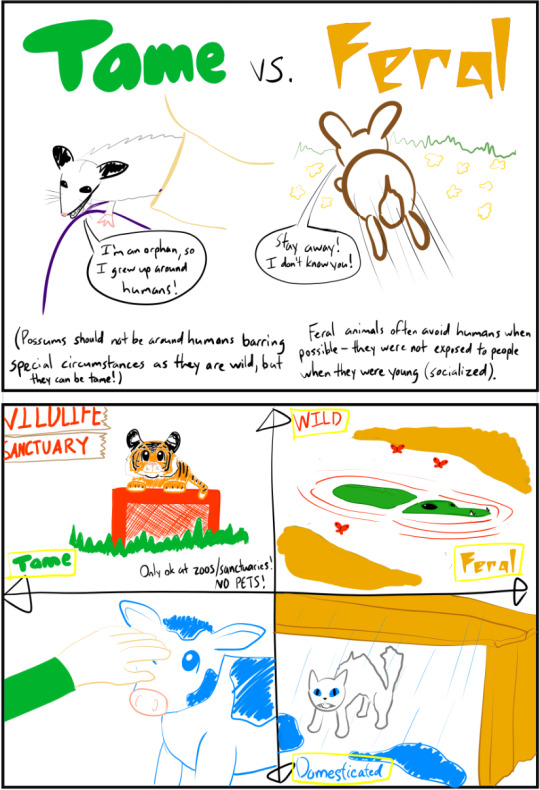

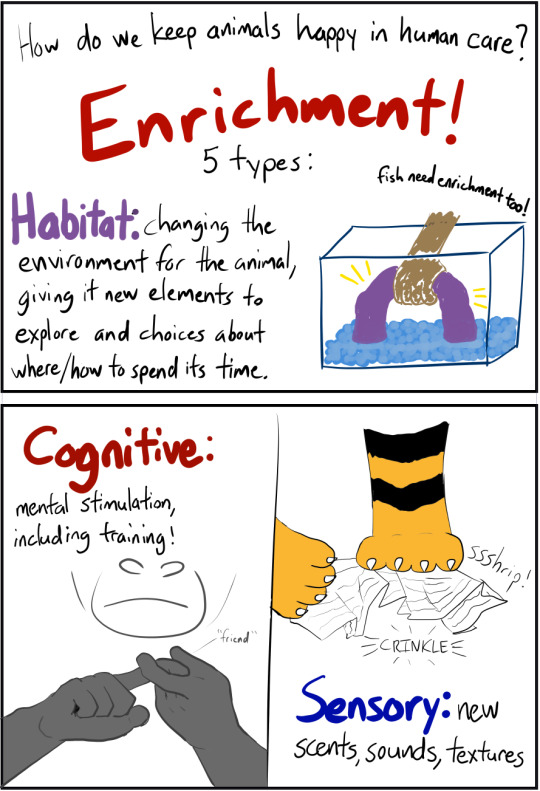

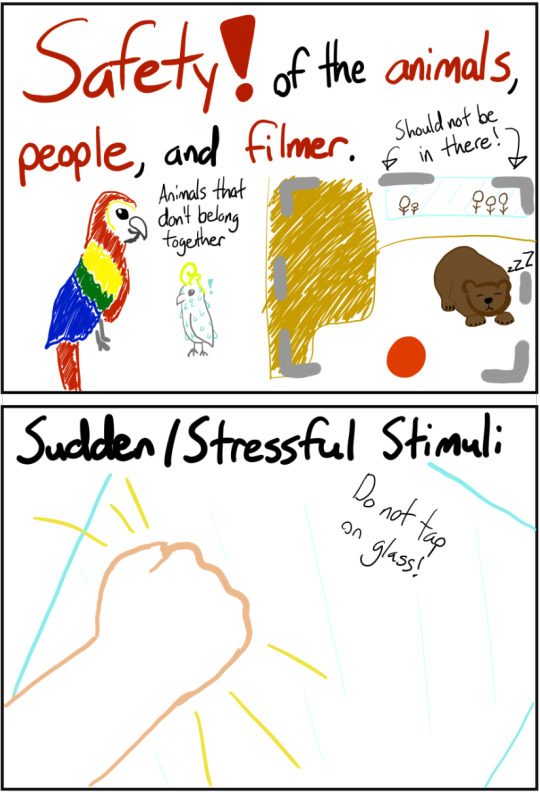
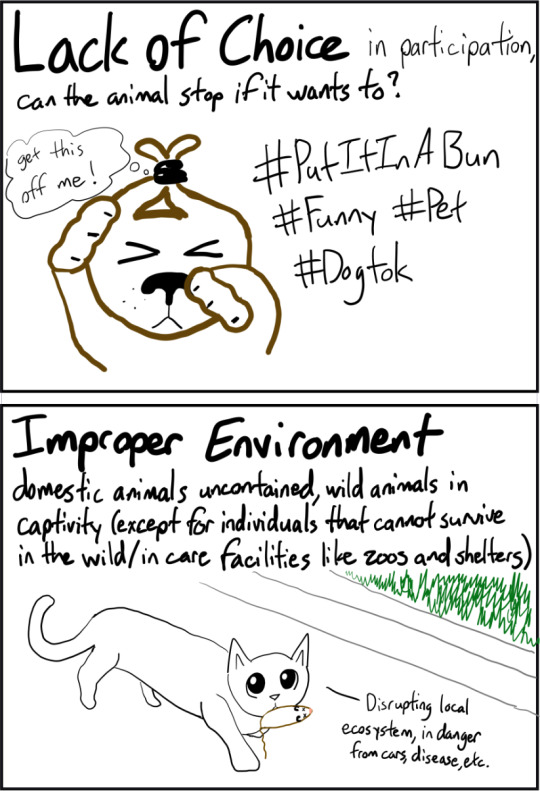
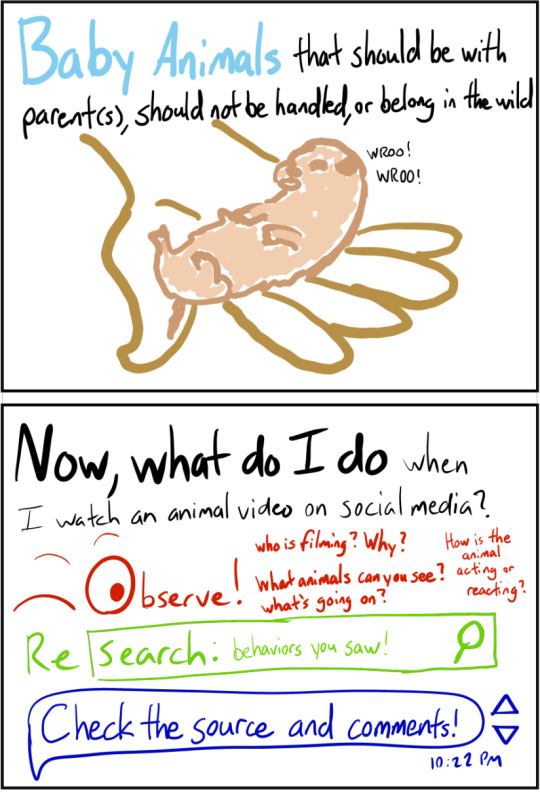


We have lots of wonderful accounts that do a great job of telling if the animal video is cute or not, but it's important for everyone to exercise critical thinking skills and learn how to analyze them too! Here's an infographic with some basics on animal science that can help you decide what to look for.
Key questions for analyzing videos:
Are all of the animals and people in the video (including the filmer) safe?
Is the animal choosing to participate?
What behavior or activity is being shown - is it a natural and positive behavior for the animal, is it enriching? Or may it be a negative behavior? You can search ‘animal’ ‘behavior’ online - like “gorilla picking itself” - for a quick check!
What’s the purpose of the video - is the situation created for the animal, or for viewers?
Is it sensible that the animal is there, doing what it is doing?
Overall - figure out what you can see, and what you need to find out/double check, and then search that! Add it all up and you should be able to draw your own conclusions too.
Please check out some of our other posts for examples on how to think through videos you may see!
Smithsonian’s National Zoo & Conservation Biology Institute. (2022, May 25). Animal Enrichment. Smithsonian's National Zoo. Retrieved March 28, 2023, from https://nationalzoo.si.edu/animals/animal-enrichment
Bielawski, J. (2017, January 5). Beware what you share! "Cute" videos are often cruel. Animal Help Now. Retrieved March 22, 2023, from https://ahnow.org/blog/2017/01/05/beware-what-you-share-cute-videos-are-often-cruel/
Goldstein, H. (2022, April 13). What to do when you see animal cruelty on Social Media. What to Do When You See Animal Cruelty on Social Media. Retrieved March 28, 2023, from https://www.worldanimalprotection.us/blogs/what-do-when-you-see-animal-cruelty-social-media
American Veterinary Medical Association. (n.d.). Animal welfare: What is it? Animal Health Welfare. Retrieved March 28, 2023, from https://www.avma.org/resources/animal-health-welfare/animal-welfare-what-it Colchester Zoo. (2022, February 11). Environmental enrichment. Colchester Zoo. Retrieved April 3, 2023, from https://www.colchester-zoo.com/about-us/environmental-enrichment/
121 notes
·
View notes